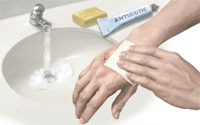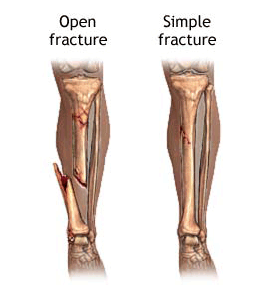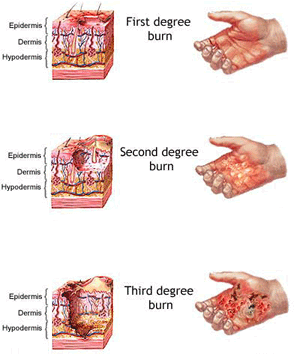While allergies are extremely common and most are not much more than a nuisance, a severe allergic reaction can quickly turn into a life-threatening medical emergency. Some common allergens that can cause an unexpected reaction are:
- Eggs
- Peanuts
- Insect bites or stings
- Chocolate
Allergic reactions can vary from itchy skin and rashes, to difficulties breathing and swelling of the face and the tongue. In such sever cases, epinephrine, a widely-available prescription drug which is injected with a device called an “epi-pen”, should be administered. If the victim has an epi-pen, help them retrieve it and monitor their condition. If epi-pen is not available, call 911 immediately.
If the victim was bitten by an unprovoked undomesticated animal such as a raccoon or a squirrel, an immediate shot may be necessary to prevent the possibility of a rabies infection. Contrary to common belief, a human bite can sometimes be more dangerous than that of an animal because human saliva contains many more types of bacteria which may cause infection.
A bite from a domestic pet can be painful but rarely requires a visit to the emergency room and unless obvious bodily harm was sustained, a simple precautionary treatment will suffice.

- Use anti-bacterial soap and water to thoroughly clean the bite wound.
- Apply antibiotic ointment such as Neosporin to prevent infection.
- If the injury resulted in broken skin, dress it with a sterile bandage and replace the dressing frequently.
- If the bite is deep, the victim may need to be treated for a puncture wound.
A breathing emergency is any respiratory deficiency which may threaten a life, and can range from shortness of breath to severe breathing interruption. Some of the primary causes of a breathing emergency are:
- asthma
- choking
- allergies
- a heart attack
- lung infection
- physical pain or injury
- prolonged smoking
- inhalation of fumes
- toxic poisoning
Respiratory emergencies associated with chronic asthma are a major cause of hospitalization, and can be triggered by everyday conditions such as excessive pollen, dust, smoke, or animal dander.
A victim who experiences a severe breathing emergency may exhibit any of the following behavior:
- shortness of breath
- wheezing or whistling sounds
- very rapid or very slow breathing
- pale or blue face and lips
- confusion and incoherence
- uncontrollable coughing
When providing assistance to someone with breathing difficulties:
- ask if the victim takes prescribed medication and help them take it
- if necessary, help administer an inhaler or epi-pen
- call 911 if the victim’s condition deteriorates
- loosen clothing and any other items around the neck and chest area
- keep the victim calm and stay with them until EMS arrives
- be prepared to administer CPR
A broken or cracked bone, or a fracture, can be separated into two categories:
- Open, or compound fracture – the bone is obviously broken and with part of the broken bone extending from the wound
- Closed, or simple fracture – no open wound is present, but the bone broken or cracked
Broken bones have sharp edges and any rough movement can cut into blood vessels, nerves, or muscles causing extreme pain. Because a broken bone doesn’t always extend through the skin, you must be able to recognize other signs of a fracture. If the victim is conscious, ask if they heard or felt their bone snap or crack. At the same time, check the victim for:
- Pain or tenderness in the region of the fracture
- Deformity or irregularity of the affected area
- Loss of function (disability) of the affected area
- Moderate or severe swelling
- Discoloration
Be careful when examining the victim, especially when they clearly sustained a fracture. You may need to maintain an open airway, control bleeding and treat for shock. Do not attempt to move the victim until they have been examined and cleared to be moved. If the victim is lying down, it’s preferable to attend to their injuries in that position, with as little movement as possible. If fractures are present, make any necessary movement in such a manner as to minimize any further injury.
Splints
Use splints to support, immobilize, and protect parts with injuries such as known or suspected fractures, dislocations or severe sprains. When in doubt, treat the injury as a fracture and splint it. Splints prevent movement at the area of the injury and at the nearest joints. Splints should immobilize and support the joint or bones above and below the break.
Many types of splints are available commercially. Easily applied and quickly inflated plastic splints give support to injured limbs. Improvised splints may be made from pieces of wood, broom handles, newspapers, heavy cardboard, boards, magazines, or similar firm materials.
Certain guidelines should be followed when splinting:
- Gently remove all clothing from any suspected fracture or dislocation.
- Do not attempt to push bones back through an open wound.
- Do not attempt to straighten any fracture.
- Cover open wounds with a sterile dressing before splinting.
- Pad splints with soft material to prevent excessive pressure on the affected area and to aid in supporting the injured part.
- Pad under all natural arches of the body such as the knee and wrist.
- Support the injured part while splint is being applied.
- Splint firmly, but not so tightly as to interfere with circulation or cause undue pain.
- Support fracture or dislocation before transporting victim.
- Elevate the injured part and apply ice when possible.
A break in the lower part of the leg requires two splints, one on each side of the leg (or at least the shin). If suitable material is not available, you can use the victim’s healthy leg as a makeshift splint.
As much as possible, keep the victim from moving and until an ambulance arrives, remember ICE:
- “I” is for ice – if possible apply an ice pack or ice cubes to the injured area. This will keep down the swelling and reduce pain.
- “C” is for compression – if the wound is bleeding, apply direct pressure with a clean cloth to reduce blood flow.
- “E” is for elevation – try to keep the injured area as high above heart level as possible. This will reduce blood flow to the injury and minimize swelling.
Burns may be classified according to extent and depth of damage as follows:

1st degree: MINOR
- The burned area is painful.
- The outer skin is reddened.
- Slight swelling is present.
2nd degree: MODERATE
- The burned area is painful.
- The underskin is affected.
- Blisters may form.
- The area may have a wet, shiny appearance because of exposed tissue.
3rd degree: SEVERE
- Insensitive due to the destruction of nerve endings.
- Skin is destroyed.
- Muscle tissues and bone underneath may be damaged.
- The area may be charred, white, or grayish in color.
Burns may also be classified according to cause. The four major types of burns by cause are as follows:
- Chemical
- Thermal
- Electrical
- Radiation
The seriousness of a burn or scald is influenced by the extent of the body surface involved, as well as by the depth to which the tissues are penetrated. Burns can do more damage than injure the skin. Burns can damage muscles, bones, nerves, and blood vessels. The eyes can be burned beyond repair. The respiratory system structures can be damaged, with possible airway obstruction, respiratory failure, and respiratory arrest. Shock is very severe when burns are extensive and may cause death in a few hours.
First Aid for Burns
The first aid given to a burn victim largely depends on the cause of the burn and the degree of severity. Emergency first aid for burns or scalds should primarily be exclusion of air from the burned area, relief of the pain that immediately follows burns, minimizing the onset of shock, and the prevention of infection.
Remove all clothing from the injured area, but cut around any clothing that adheres to the skin and leave it in place. Keep the patient covered, except the injured part, since there is a tendency to chill. First aid dressings for burns and scalds should be free of grease or oil. The use of greases or oils in the treatment of burns makes it necessary to cleanse the burned or scalded areas with a solvent before medical treatment can begin. This delays the medical treatment and is very painful.
Be careful when dressing burns and scalds. Burned and scalded surfaces are subject to infection the same as open wounds and require the same care to prevent infection. Bandages should be loose enough to prevent pressure on burned surfaces. As swelling often takes place after burn dressings have been applied, check them frequently to see that they are not too tight. Watch for evidence of shock and treat if it is present. In cases of severe burns, transport the victim to the hospital as quickly as possible.
Burns of the Eyes by Chemicals
Frequently chemical substances, especially lime, cement, caustic soda, or acids or alkalis from storage batteries get into the eyes. The treatment is to wash the eyes freely with clean water. To do this, have the victim lie down, hold the eyelids open with the fingers and pour the water into the inner corner of the eyes from a pitcher or other container. Use plenty of water and wash the eyes thoroughly, being sure the water actually flows across the eyes. Do not put neutralizing solution in the eyes. Cover both eyes with moistened sterile gauze pads and secure in place. Chemical burns of the eyes should receive the attention of an eye specialist as soon as possible.
Chemical Burns
General first aid for chemical burns is as follows:
- Remove all clothing containing the chemical agent.
- Do not use any neutralizing solution, unless recommended by a physician.
- Irrigate with water for at least 15 minutes, use potable water if possible.
- Treat for shock.
- Transport to a medical facility.
First aid for dry chemical (alkali) burns is an exception to the general first aid for chemical burns because mixing water with dry alkali creates a corrosive substance. The dry alkali should be brushed from the skin and water should then be used in very large amounts.
Thermal Burns (Minor)
General first aid for minor thermal burns is as follows:
- Use cool, moist applications of gauze or bandage material to minimize blistering.
- Treat for physical shock.
If the victim has thermal burns on the eyelids, apply moist, sterile gauze pads to both eyes and secure in place.
Thermal Burns (Moderate and Critical)
General first aid for more serious thermal burns is as follows:
- Do not use cold applications on extensive burns; cold could result in chilling.
- Cover the burn with a clean, dry dressing.
- Treat for shock.
- Transport to a medical facility.
Electrical Burns
General first aid for electrical burns is as follows:
- Conduct a primary survey, as cardiac and respiratory arrest can occur in cases of electrical burns.
- Check for points of entry and exit of current.
- Cover burned surface with a clean dressing.
- Splint all fractures. (Violent muscle contractions caused by the electricity may result in fractures.)
- Treat for physical shock.
- Transport to a medical facility.
Respiratory failure and cardiac arrest are the major problems caused by electrical shock and NOT the burn. Monitor pulse and breathing while preparing victim for transportation.
Radiation Burns
Radiation presents a hazard to the rescuer as well as the victim. A rescuer who must enter a radioactive area should stay for as short a time as possible. Radiation is undetectable by the human senses and the rescuer, while attempting to aid the victim, may receive a fatal dose of radiation without realizing it. Notify experts immediately of possible radioactive materials contamination.